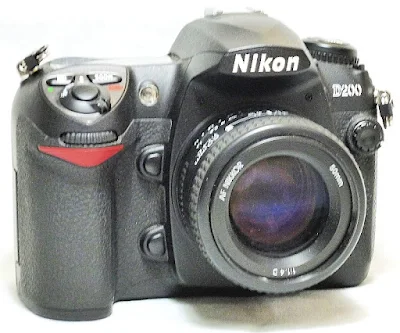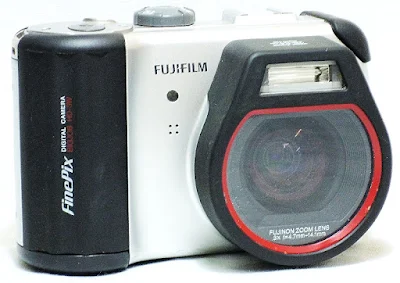After going through 2023 with my GAS (Gear Acquisition Syndrome) in top gear, I ended up with a fair collection of mostly digital cameras with CCD sensors and a small range of film cameras. As a hobbyist, I was shying away from film photography for the past couple of years due to the volatility of prices of film for film photography and concentrated on CCD imagery instead, The urge to come back to film, however, was strong enough to succumb me to a couple of film camera buys for the year.
Why CCD sensors? CCD sensors were the standard for digital cameras from the early 1980s until the late 2000s, acknowledged for their high-quality, low-noise images, with renderings that some people say are almost film-like. Like the resurgence of interest in film photography, moving back to CCD imagery could be equally rewarding. While CCD sensors are not normally fitted to commercial-issue digital cameras of late, they are still used in areas of specialized photography, including Optical Microscopy, Space Photography, and Near-Infrared Imaging.
For those contemplating the move, vintage digital cameras, or digicams, with CCD sensors are readily available at low prices on the auction markets or even in brick-and-mortar stores. These include makes and models manufactured towards the end of their production run, before the switch to the CMOS variety. Some are still available spick and span, in mint or near-mint condition, while others may be hardly used. And, of course, if you are using a digital camera, you will have the advantage of doing away with recurring costs for film and its associated charges.
Out of the five picks that I have lined up for 2024, four are digitals with CCD sensors - the ubiquitous digital SLR, a digital bridge, an all-weather compact, and finally, an ultra-compact. The choice underlies my interest in the 'Re-Living the CCD Sensor' series, which I am promoting as an alternative low-cost approach to sustain and further my interest and enthusiasm in photography. For the film variety, my pick is a 35 mm SLR film camera with Eye-Controlled Focus, a feature that might not be as relevant to some but is of major interest to me:
Canon EOS 55 (EOS Elan IIE, EOS 50E)
The dual-format Canon EOS 55 (Japanese domestic market, with cropped-frame panorama feature) launched in 1955 was also made available as a single format 35mm SLR film camera in the US as the EOS Elan IIE, and in Europe as the EOS 50E. The camera is the second iteration of the Canon EOS 35mm SLR film camera series that has Eye-Controlled Focus, a feature unique to Canon, that permits focusing to an autofocus point your eye is looking at on the viewfinder screen.
The innovative Eye-Controlled Focus was first featured on the EOS 5 QD in 1992 (EOS A2E / A2 in the US, EOS 5 in Europe) with 5 horizontal AF points. After the EOS 55, which has 3 AF points that can be calibrated both horizontally and vertically, the feature was implemented again on the professional grade EOS 3 in 1998 (with a complex 45-point system), and with 7 AF points on the EOS 7 (EOS Elan 7E / EOS 30) in 2000, and EOS 7s (EOS Elan 7NE / EOS30V) in 2004.
On the digital front, the Eye-Controlled Focus feature was first implemented on EOS 5D in 2005 (with 9 AF points), and in 2021, a very advanced whole-screen setup on the mirrorless EOS R3 was released. While I did not see myself moving forward to the more advanced and higher-cost options of current digital cameras, going back to the challenge of film imagery with eye-controlled focusing may not only be interesting, but it could also be equally rewarding.
Nikon D200
The professional grade Nikon D200, launched in 2005, comes with a 10.2 MP CCD sensor, a shutter speed range from 30 to 1/8,000 seconds, an ISO range from 100 to 1,600, a top LCD panel for display of operating parameters, a very bright and sharp 2.5 inch 230,00 pixels rear LCD, 7 area AF, operates in Program, Shutter priority, Aperture priority, and Manual modes, and captures images in JPEG and (NEF) RAW.
The D200 is a well-built and robust DSLR camera with a magnesium alloy chassis, environmental seals, an excellent user interface, an exceptional feature set, and reputedly, an excellent performer. The camera has a 'screw-drive' AF, which can be used with Ai manual focus and essentially all other Nikkor lenses manufactured from 1977 onward. It also has an intervalometer for time-lapse photography.
Though slightly heavy by today's standard, the D200 is a hefty 830 grams without a battery, memory card, body cap, or monitor cover. The power supply for the camera is a Nikon EN-ELe3 Lithium battery pack, which also powers earlier CCD sensors Nikon D50, D70, D70s, D80, D90, D100, and later CMOS sensors D300, and D300S. The best alternate option for a CCD Nikon with a 'screw-drive' AF is the Nikon D80, which is an entry-level model.
Panasonic Lumix DMC-FZ35/38
I went through a range of the Lumix DMC-FZ series, from the FZ18 to the FZ45, before picking the 12.1MP CCD Lumix DMC-FZ35 (2009) as my optimal choice for a superzoom digital bridge camera. Others may prefer the longer 25-600mm equivalent zoom and the better features of the 14.1MP CCD FZ40 (2010). I am happy enough with the 27-486mm equivalent 1:2.8~4.4 18X optical zoom 27mm Leica DC Vario-Elmarit wide-angle lens, which has a better handhold ability for me.
The camera, successor to the DMC-FZ28, was among the first to feature AVCHD lite format HD video recording, has a shutter speed range from 60 seconds to 1/2000th second, Power O.I.S image stabilizer, a faster Venus Engine HD processor, and a Quick AF system twice as fast than that of the predecessor, an in-line Electronic Viewfinder (EV) with dioptre adjustment, and a 2.7-inch 230,000 pixels live view TFT LCD.
The ease and convenience of a lightweight, at 414 grams with battery and card, for travels and a day with the family at the beach is, of course, unforetold. The FZ35 supports both JPEG (with two compression levels) and raw file capture for still images in three aspect ratios. Changes to the aspect ratio were made by cropping the top and bottom of the frame, with the horizontal pixel count remaining identical on all three aspect ratios.
FujiFilm FinePix BigJob HD-3W
For the rough and tough outdoors, and for me, a trek in the rain, the pick is the Fujifilm FinePix BigJob HD-3W, a 6MP CCD ruggedized all-weather digital camera built for the construction and engineering industry. The camera comes with a 3x wide-angle Fujinon 4.7-14.1 (28-84mm equivalent) lens, a shutter speed range from 2 to 1/2000 second, a 3-inch LCD with reinforced glass coating, a hotshoe, ISO 1600 capability, and a body that is water, shock, and dustproof.
The autoexposure BigJob is easy to operate, made simple with easy access buttons, with mode dial, and menu systems that are accessible even for users with gloves. On its own, the BigJob HD-3W is also accredited with two world firsts, a Detection Manipulation feature that highlights any tampering to images after the photo has been taken (via viewer software on a computer), and a CALS mode that shoots images at 1MP, for attaching and distribution via email.
The camera is also programmed with a Shot Date function, making it functionally useful for monitoring and reporting work progress, insurance, and forensic applications, and a manual mode where the ISO speed setting can be adjusted for over and underexposure shots. The camera is reminiscent of the equally rough and tough 35mm film camera Fuji Work Record OP.
Panasonic Lumix DMC-S5
My current, surprisingly, product shoot camera, the 16MP CCD Panasonic Lumix DMC-S5, introduced in 2012, is a follow-up of the DMC-S series, which includes the DMC-S1 (2011), DMC-S3 (2011), and DMC-S2. The camera was updated with a new, higher-resolution image sensor, an updated autofocus system, an improvement in battery life, a reduction in burst-shooting speed, and updated software.
The camera, with a Lumix DC Vario Asph. 4x Optical Zoom lens, has a true optical image stabilization system, comes with the Panasonic Venus Engine image processor, a 2.7-inch 230,000 dot resolution LCD display, and a 23-point multi-area/single-point autofocus, with face detection. ISO sensitivity is from 100 to 1,600, and a shutter speed ranges from 8 seconds to 1/1,600 seconds.
I have been using this camera for almost a year now, and as I have not seen any potential replacement for it, I will probably use it through 2024. It started as a trial replacement for an aging and wonky DSLR with my makeshift studio set-up, turned up good images (including all the images posted on this page), and has stayed on since. The DMC-S5 in the photo is the second unit that I have.



















No comments:
Post a Comment